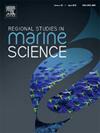Seasonal variability of trace metal accumulation in seagrass (Cymodocea rotundata) at the Dongsha Atoll, South China Sea
IF 2.1
4区 环境科学与生态学
Q3 ECOLOGY
引用次数: 0
Abstract
In this study, trace metal levels of seagrass (Cymodocea rotundata) were used as bioindicators to investigate the variability of trace metals in a remote atoll (Dongsha) on the continental slope of the South China Sea. Seagrass samples were collected (bi)weekly from December 2014 to March 2016, and water and sediment samples were also collected several times during the period. To assess the temporal variability of trace metals in this region, which is influenced by different monsoon-bearing atmospheric sources, especially anthropogenic ones, the concentrations of trace metals (Cd, Cu, Ni and Zn) in all three types of samples were determined. Among the different media, sediment and seagrass showed similar spatial variability in trace metal content. Water samples showed no discernible spatial or temporal trend for the particular elements. Our results showed that trace metal concentrations in seagrass collected during the northeast monsoon season (winter-spring) were on average 52 % higher for Cd, 28 % for Cu, and 17 % for Zn than those collected during the southwest monsoon season (summer-autumn). These results are consistent with atmospheric trace metal concentrations obtained during parts of the same study period. This implies that trace metal content in seagrass is not only influenced by local sources, but may also serve as an indication of atmospheric trace metal sources transported to the offshore Dongsha Atoll in the South China Sea.
求助全文
约1分钟内获得全文
求助全文
来源期刊

Regional Studies in Marine Science
Agricultural and Biological Sciences-Ecology, Evolution, Behavior and Systematics
CiteScore
3.90
自引率
4.80%
发文量
336
审稿时长
69 days
期刊介绍:
REGIONAL STUDIES IN MARINE SCIENCE will publish scientifically sound papers on regional aspects of maritime and marine resources in estuaries, coastal zones, continental shelf, the seas and oceans.
 求助内容:
求助内容: 应助结果提醒方式:
应助结果提醒方式:


